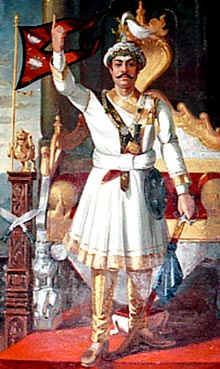Prithvi Narayan Shah
Prithvi Narayan Shah (* 1722 , † 1775 ; Nepali: पृथ्वीनारायण शाह Prithvi Nārāyaṇ Shah ) is considered the founder of Nepal , who operated through wars and annexations to unite the numerous small principalities to form the Kingdom of Gorkha and thus to the state of Nepal.
Life

Prithvi Narayan Shah was the ninth generation of the Dravya Shah (1559-1570), the founder of the Shah dynasty of Gorkha. The ancestors were Sisodia Rajputs from Chittorgad in today's Rajasthan , who fled from the Arab invaders and settled in the area of today's Gorkha district in Nepal. The principality of Gorkha was one of about 50 principalities that existed in the area of today's Nepal. Prithvi Narayan Shah succeeded his father Nara Bhupal Shah to the throne in 1743 .
Prithvi Narayan Shah's policy of annexation began in 1744 with the capture of Nuwakot , which lay between Gorkha and the Kathmandu valley . Then he gradually occupied the heights around the Kathmandu valley; When the Kuti Pass was blocked in 1756, the valley was closed off from the outside world and trade with Tibet and the Mughal Empire ( India ) was interrupted. When taking the valley, the Gorkhali encountered strong resistance and were only able to take Kirtipur on the third attempt. The angry conquerors took revenge on the city population with murder and mutilation. In the years that followed, the Gorkhali took the neighboring kingdoms of Kathmandu , Patan and finally Bhaktapur , bringing the entire valley under their rule. Narayan Shah then moved his capital from Nuwakot to Kathmandu in 1768. After that the Gorkhali pressed further east; In 1773 the Sen kingdoms Chaudandi and Vijaypur were taken one after the other.
In the Divya Upadesh , Prithvi Narayan Shah put together nine principles and guidelines according to which his kingdom should be governed and show his foresight. In it he describes z. B. Nepal as being sandwiched between two rocks, with the latter referring to the neighbors China and India. Therefore his empire should keep an eye on the strengths of these neighbors and always pursue a policy of negotiation and compromise. This guideline is still valid in Nepal today. In the Divya Upadesh, Prithvi Narayan also exhorts to cultivate friendly relations with China and to be on guard against the British . Indeed, war broke out with the English in 1814 , which put an end to Gorkha's expansion.
Prithvi Narayan Shah died in January 1775 at the age of 52; the throne was taken by his son Pratap Singh Shah , who died after two years. The crown went to his only two-year-old son Rana Bahadur Shah . Pratap's younger brother and uncle of the heir to the throne, Bahadur Shah, continued Narayan Shah's policy of annexation.
Individual evidence
- ↑ Baburam Acharya: Shree Panch BadaMaharajdhiraj Prithivi Narayan Shah ko Sanxipta Jiwani, Part I ( Nepali ), p. 42.
- ↑ Baral, Leelanateshwar Sharma. (1964). Life and Writings of Pritivi Narayan Shah (PDF; 17.2 MB)
| predecessor | Office | successor |
|---|---|---|
| Nara Bhupal Shah |
King of Nepal 1768–1775 |
Pratap Singh Shah |
| personal data | |
|---|---|
| SURNAME | Prithvi Narayan Shah |
| ALTERNATIVE NAMES | Prithvi Narayan Shah Dev |
| BRIEF DESCRIPTION | King of Nepal |
| DATE OF BIRTH | 1722 |
| DATE OF DEATH | 1775 |
